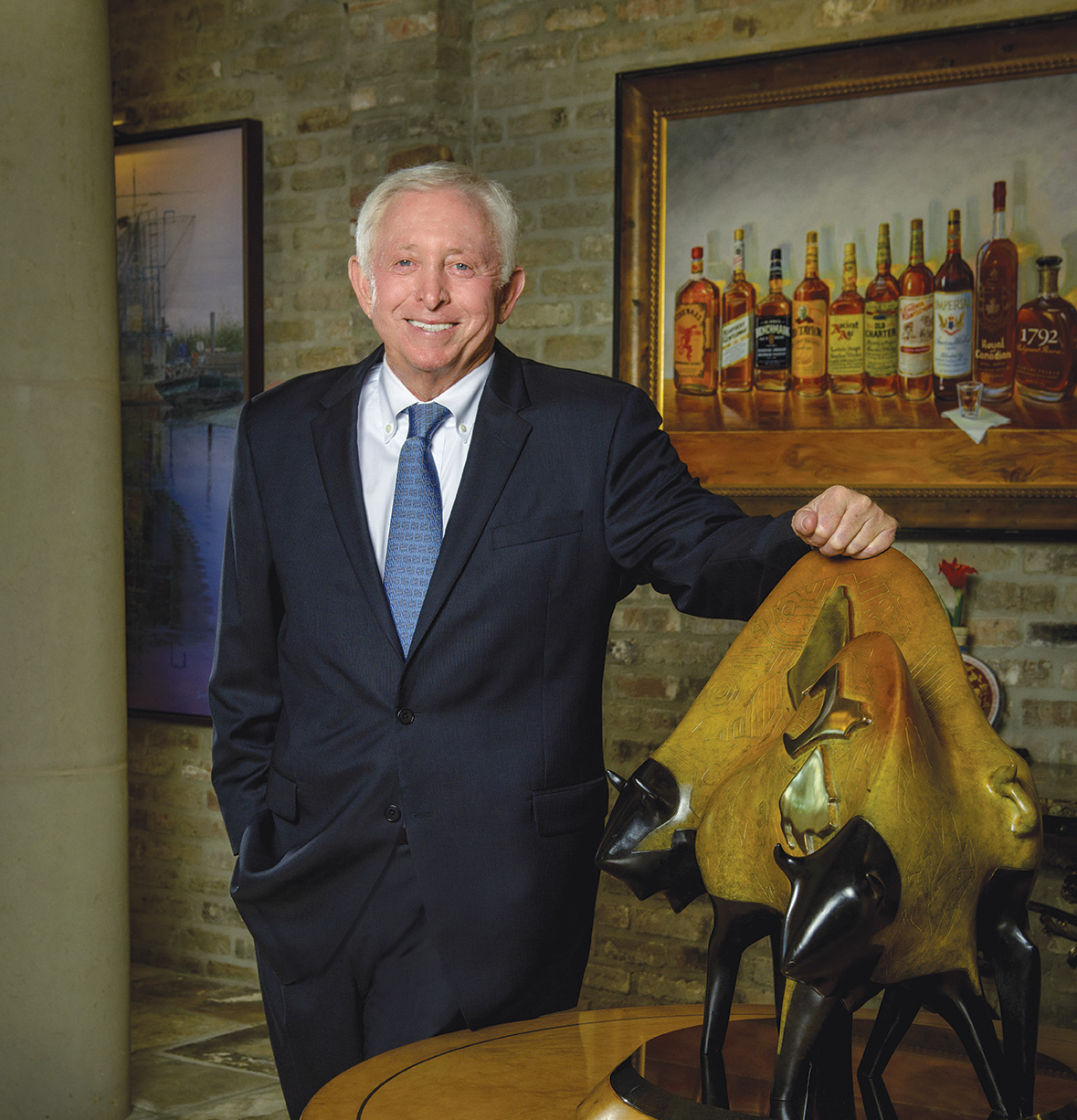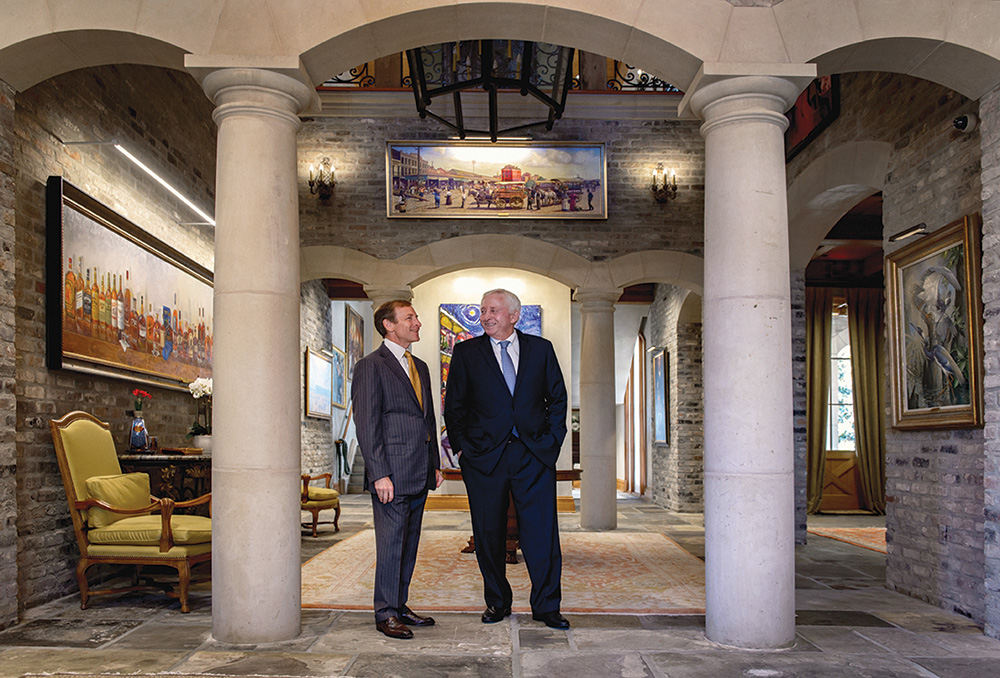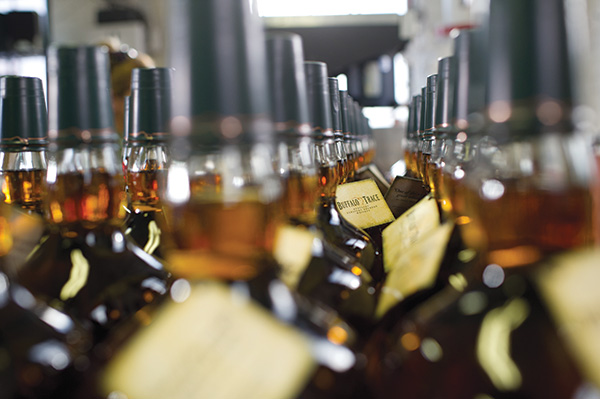
William A. “Bill” Goldring (BBA ’64) has quietly built the New Orleans-based Sazerac Co. into the largest producer of distilled spirits in America, with a portfolio of top-selling brands including Buffalo Trace, Southern Comfort, Fireball, Eagle Rare and Pappy Van Winkle. Just as significantly, he’s also used his business success to fundamentally transform the physical, cultural and educational landscape of New Orleans. Now, through an anchor gift to Tulane University for the expansion of the A. B. Freeman School of Business, Goldring is lending his family’s name and support to the third major business school building campaign of his lifetime.
Paul Fine didn’t want the job.
It was 1994, and Fine (MBA ’88), treasurer and vice president for finance at Tulane University, had been contacted by a headhunter to interview for a position as businessman Bill Goldring’s chief financial officer. Goldring, a member of the Board of Tulane, had been impressed with Fine’s presentations to the board and asked Tulane President Eamon Kelly for special permission to interview him for the job.
The attraction, however, wasn’t mutual.
“I went home and told my wife, ‘I don’t want to work for this guy,’’’ Fine recalls. “I said, ‘He’s this real quiet guy in these board meetings. He doesn’t say much. I think he has some warehouse out on Jefferson Highway, but I’m not sure what he does.’”
To avoid offending his prominent suitor, Fine reluctantly agreed to go through with the interview. On the morning of his meeting, Fine walked into Goldring’s office and sat down, fully intending to inform him that he was happy at Tulane and not interested in coming to work for him.
But then something happened.
Goldring twirled around in his chair and picked up a volume detailing the history of his family’s companies. He got up from behind his desk, walked over to Fine and sat down next to him, pulling their two chairs together until the arms touched. And then he began to talk about the business. He spoke about his grandfather, Newman Goldring, an Eastern European immigrant who started a Schlitz beer distributorship on the panhandle of Florida in 1898. He spoke about his father, Stephen Goldring, a law school graduate and former stock broker who with his partner Malcolm Woldenberg founded Magnolia Liquor Co., a wine and spirits wholesaler, in 1944 and purchased the Sazerac Co., a liquor manufacturer, in 1948. Goldring spoke proudly about how the companies had grown under his family’s guidance and enthusiastically about his vision for growing them further.
Fine was astonished.
“He was different guy, a guy I had never seen at Tulane,” Fine recalls, a smile spreading across his face. “His eyes sparkled and he got excited and you could just see the passion. I was sold in 30 seconds. I went home and told my wife, ‘I need to take this job.’”
Today, more than 22 years later, Fine remains just as inspired by Goldring’s passion and drive as he was that afternoon back in 1994.
“He’s very passionate about his business,” says Fine, president and CFO of Goldring Family Interest, which oversees the family’s companies. “It’s almost his singular focus in life. He has a saying on a poster in his office, ‘You’re either the hunter or the hunted. Either way, you better wake up every morning running.’ And that’s Bill.”
William A. “Bill” Goldring celebrated his 73rd birthday in January. That’s an age when some executives might begin to contemplate retirement or at least reducing their day-to-day involvement, but the longtime chairman of the Sazerac Co., the nation’s largest producer of distilled spirits, and Crescent Crown Distributing, the nation’s fourth-largest beer wholesaler, shows no sign of slowing down.
“I’m going till I’m 113 years old,” he says with a poker face. “You think I’m joking, but I tell my kids I want to be in their will.” His kids would do well to listen. A health nut, Goldring works out every day, plays tennis and maintains a healthy diet. His recent gift to help establish the Goldring Center for Culinary Medicine at Tulane School of Medicine, in fact, was based on his belief in the important role that diet plays in the prevention of chronic diseases.
But Goldring’s aspirations to supercentenarian status are based on more than his good health. It’s part of his wiring.
“Bill is one of the most competitive people I know,” says Sazerac Co. President and CEO Mark Brown (MBA ’90), who’s worked with Goldring for more than 30 years. “He loves to win. He hates losing.”
“He’s very dedicated, very detail oriented and very involved in the business every day,” adds Fine. “He cares about the littlest things.”
On a typical day, Golding might call a wholesaler to demand that his brands get more advertising placements on its fleet of trucks or bring a group of employees into his office to gauge their reaction to 10 different bottle designs. If Fine calls him with an issue he’s having with one of their banks, Goldring might conference in the bank’s president to resolve the issue on the spot. When he eats out at a restaurant or attends a catered event, he makes a point of inspecting the bar. It’s not unusual for employees to receive emails from Goldring late at night asking why one
of their brands wasn’t available.
Goldring’s competitive streak has been known to reach almost comic levels. He once poured the contents of a friend’s liquor cabinet down the drain when he saw it was full of a competitor’s brands. (He restocked the cabinet the next day with his brands.)
That intensity of dedication might lead you to believe that Goldring is an inveterate micromanager and control freak, but those who work with him say he’s actually just the opposite.
“The beauty of our relationship is that he’s been almost completely hands off,” Brown says. “We talk a lot and he has opinions about things, but he very much lets us, the team, go off and do what we need to do.”
“He stays on top of people and holds them accountable, but he lets them run their segment of the business,” adds Jeffrey Goldring (BSM ’89), Bill’s son and a co-owner and director of the Sazerac Co. “I think one of the things that’s made him successful is he gives people the autonomy to do what they need to do to run the business. And he’s really had to do that as the business has continued to grow.”

Bill with his son Jeffery Goldring (BSM ’89), a co-owner and director of the Sazerac Co.
In 2010, Goldring sold his ownership stake in Republic National Distributing Co., the successor to Magnolia Liquor Co. and at the time the nation’s second-largest wholesaler of wine and spirits. From the outside, it might have looked like Goldring was liquidating his assets as he approached retirement age. In reality, he was preparing for the next stage in his business career.
“I never envisioned getting out the wholesale business,” Goldring says, “but I never envisioned that Sazerac would grow as big as it did.”
With nearly 2,000 employees, 300 brands and revenues that have doubled every five years for the last 30 years, the Sazerac Co. isn’t just the largest producer of distilled spirits in America. It’s one of the largest in the world, with a diverse portfolio of top-selling brands including Buffalo Trace, Fireball, Blanton’s, Taaka, Eagle Rare, Margaritaville, Old Mr. Boston and its latest acquisitions, Southern Comfort and Paddy Irish Whiskey.
It’s also, perhaps surprisingly, one of the oldest family-owned businesses in New Orleans.
The company traces its origins to 1850, when a French Quarter businessman opened a saloon whose specialty was a potent toddy consisting of Sazerac-de-Forge et fils brandy with a dash of apothecary Antoine Peychaud’s aromatic bitters. In deference to his signature cocktail, he called his saloon the Sazerac Coffee Shop.
In 1871, a subsequent owner of the saloon, Thomas H. Handy, started a side import and manufacturing business which became known as the Thomas Handy Co. Handy also altered the recipe for the Sazerac cocktail, replacing brandy with rye whisky and adding a drop of absinthe.
In 1919, the dawn of Prohibition forced the closing of the Sazerac Coffee House, but the import and manufacturing business lived on with a new name: The Sazerac Co. In 1933, following the end of Prohibition, the Sazerac Co. resumed its alcohol manufacturing business, producing Peychaud’s bitters and a pre-mixed version of the Sazerac cocktail.
It was that tiny manufacturing company that the founders of Magnolia Liquor Co., Stephen Goldring and Malcolm Woldenberg, purchased in 1948 to complement their fledgling wholesale business.
For much of its 20th century existence, the Sazerac Co. was known primarily for one product: Taaka vodka, the value brand that Goldring and Woldenberg introduced in 1958 and which eventually became one of the top-selling vodkas in America.
“People were drinking bourbon in those days,” Goldring says. “Vodka had no taste, no odor and no age, but it ended up becoming popular for those same reasons. Because it didn’t have any taste, you could mix it with anything, and because it didn’t have any odor, it didn’t leave any smell on your breath if you had drink at lunchtime. Over a period of time, vodka ended up with a third of the total spirit business in America, and the sales of bourbon went into a tailspin.”
On the strength of Taaka, the Sazerac Co. grew modestly through the 1970s and 1980s, but it was a decision Goldring made in 1992 that ultimately set the company on its current trajectory.
That was the year Goldring purchased a dilapidated distillery on the banks of the Kentucky River in Frankfort, Kentucky. At first glance, Goldring’s decision to acquire the former Ancient Age distillery was ill-conceived at best. Bourbon sales were nearing an all-time low, and the antiquated facility was drowning in its own costly inventory. But Goldring’s vision for Sazerac had always involved bourbon, and if his experience with Taaka had taught him anything, it was that consumer tastes can change.
“Ancient Age was always noted for being one of the best distilleries in America, but they had overproduced,” Goldring says. “We stepped in and bought the inventory, and we basically got the distillery for free.”
Rechristening it Buffalo Trace Distillery, the Sazerac Co. spent seven years and millions of dollars renovating and modernizing the historic facility. In 1999, the distillery rolled out its first new product, the super-premium Buffalo Trace bourbon, and purchased two well-regarded brands, W. L. Weller and Old Charter. Malt Advocate Magazine recognized the company’s achievements by naming Buffalo Trace its Distillery of the Year in 2000, making it the first American distillery to earn the prestigious honor.
And then bourbon sales began to rise.
Fueled by changing consumer tastes, bourbon and Tennessee whiskey sales in the U.S. climbed 87 percent between 2005 and 2015, to $2.9 billion, while exports nearly doubled to $1.1 billion. For the Sazerac Co., which had just invested millions in increasing its production and storage capacity, the timing couldn’t have been more perfect.
“You can distill vodka today and put it in a bottle tomorrow,” Fine says. “You can’t do that with bourbon. You’ve got to make it and let it sit in a barrel for many years. And if you have a seven-year- old bourbon, you’re going to have seven years of inventory built up before you sell the first bottle. That’s a lot of capital.”
“When you’re making bourbon, you’ve got to look 10 years down the line because to make a good bourbon, it takes seven or eight years,” Goldring adds. “You’ve got to have that vision to know where you’re going.”
Today, Buffalo Trace produces more than 25 different bourbons, from Eagle Rare, Blanton’s and George T. Stagg to E.H. Taylor, W.L. Weller and the most celebrated of all, Pappy Van Winkle, whose ridiculously rare 23-year-old reserve can retail for as much as $2,500 a bottle. In the last 16 years, wine and spirits writers have honored Buffalo Trace with 15 best distillery titles and more than 300 awards for its whiskies, more than any other producer.
While bourbon has been the primary driver of growth, it’s not the Sazerac Co.’s only major success story. The company also produces Fireball Cinnamon Whisky, the phenomenally popular cinnamon liquor that Bloomberg Businessweek called “one of the most successful liquor brands in decades.”
Originally introduced in Canada in the early 1980s as Dr. McGillicuddy’s Fireball Whisky, part of a line of flavored schnapps, the Canadian whisky-based beverage failed to catch on in America. The Sazerac Co. acquired Dr. McGillicuddy’s in 1989, but it wasn’t until 2007 — when the company renamed it Fireball
and introduced its fire-breathing demon logo — that the brand began to take off.
Promoting it exclusively through social media and via roving brand ambassadors, who traveled the country buying shots for anyone willing to sample them, the Sazerac Co. transformed the spicy spirit into the best-selling whiskey in America.
“In seven years, we took it from a zero base in the United States to the No. 1 call brand in America,” Goldring says. “And now it’s become a global brand as well.”
By 2010, the Sazerac Co.’s explosive growth had begun to create some tension with Republic National Distributing’s suppliers, who quietly wondered if the wholesaler was as focused on selling their brands as it was on selling Sazerac products. There was also the issue of ownership. The Goldring family owns the Sazerac Co. outright whereas Republic had grown through a series of partnerships and joint ventures. After 112 years in the liquor wholesaling business, Goldring made what he calls the toughest decision of his life, to sell his ownership stake in Republic National.
“Would you rather be the Coca-Cola Co. and own the syrup or a wholesaler and own trucks and warehouses?” Goldring says. “The wholesale business is a good business, but you’re at the mercy of big retailers and big suppliers. Sazerac, over a period of years, had become bigger than almost all our suppliers, so I had to make a decision to sell other people’s brands or to sell my brands. I decided to focus on Sazerac, and that’s enabled us to become what we are today.”

When Goldring celebrated his 21st birthday, his father and mother presented him with a letter detailing theirhopes for him as he transitioned to adulthood. In addition to wishes for health, happiness and success, the letter encouraged Goldring to give back to his community.
“Intelligent use of wealth can bring power and happiness, not only to you, but to many,” his parents wrote. “Wealth can also bring you much happiness and satisfaction by helping others. As you get older, you must serve the community. Give time as well as money. You will reap self-satisfaction.”
Goldring has heeded that advice, and one doesn’t have to look far to see the evidence: There’s Woldenberg Park along the Mississippi River, the Goldring/Woldenberg Great Lawn in City Park, Goldring Hall in the Ogden Museum of Southern Art, Goldring Plaza at the Audubon Zoo, the Goldring-Woldenberg Jewish Community Center and the Woldenberg Village Retirement Center. He and his family have also provided major gifts to the National World War II Museum, the New Orleans Museum of Art, the Contemporary Arts Center, Touro Infirmary, NO/AIDS Task Force, the Urban League of Greater New Orleans, Covenant House, Temple Sinai, KIPP Public Charter Schools, Teach for America and the Posse Foundation.
“One thing we’ve tried to do is donate where we can make the greatest impact on people,” Goldring says. “Health has been important, and education is very important.”
Probably the single biggest beneficiary of Goldring’s philanthropy has been Tulane University. Beginning with his support of intercollegiate athletics in the late 1970s, Goldring has provided naming gifts for projects including the Goldring Tennis Center, the Woldenberg Art Center, the Goldring Center for Culinary
Medicine and the Goldring Institute of International Business. He also donated a 17-acre tract of land to the university for the development of an “Olympic Village” which will include a world-class tennis stadium, track and field stadium, soccer fields and beach volleyball courts.
“We have a great tennis program which has produced three NCAA No. 1 players, so we’ve got to have courts,” Goldring says. “The Olympic Village could be used by the entire university and it can be a gathering place for student life. I think it’s really, really important.”
In 1986, Goldring provided an anchor gift for the construction of Goldring/Woldenberg Hall. The new home of the A. B. Freeman School of Business was the first academic building to be built on Tulane’s uptown campus in nearly 20 years. In 2003, he provided a second major gift for the construction of Goldring/Woldenberg Hall II, the business school’s center for graduate and executive programs.
Now, for the third time in his career, Goldring is providing an anchor gift for a business school building campaign. With Goldring’s support, the $35 million expansion and renovation project will add 45,000 square feet of space to the Freeman School and convert its two buildings into a unified structure to be known as the Goldring/Woldenberg Business School Complex.
In 2015, AACSB, the leading accrediting organization for collegiate schools of business, named Goldring one of its inaugural “100 Influential Leaders” to recognize his contributions to business education and honor his lifetime of leadership and entrepreneurial success.
But as remarkable as Goldring’s record of public philanthropy is, friends say it’s only part of the story.
“He does things that you know about, but he also does a lot of things that you don’t know about because he never shares it with the community for recognition,” says businessman Coleman Adler II, a longtime friend. “He doesn’t need to make himself bigger in life. He’s big enough. The most impressive things he does are the things that nobody knows about.”
A good example is Goldring’s employee scholarship program. In 1997, he began offering full college scholarships to the dependents of all his employees. The only requirements for eligibility are that the student take 12 hours of coursework and earn a 2.5 grade point average. To date, more than 1,500 young men and
women have attended college through the program.
Goldring also gives freely of his time. He serves on the boards of over a dozen organizations, including the Board of Tulane and the Business School Council, and while he may not be the loudest voice in the room, his actions speak volumes.
“Bill isn’t the chairman of everything and he’s not the face of the organization,” Fine says. “But when things need to get done, Bill will sit in his office and get on the phone and call the people who are going to influence the decision. He gets done what needs to get done, very quietly, one-on-one. And he can be very persuasive.”
When the Sazerac Co. purchased Southern Comfort in March 2016, the acquisition doubled the company’s international distribution to 102 countries and set the stage for its next horizon: the world. Buffalo Trace is already popular in London and Tokyo, and with global interest in American whiskey projected to rise steadily, the Sazerac Co. has been building new warehouses every five months to keep up with expected demand.
“We have a vision of where we want to be in 2020, 2030 and 2040,” Goldring says with a smile. “All we need is the whiskey.”
And as he enters his fifth decade in the business, he’s having more fun than ever.
“It’s not a job,” he says. “It’s fun. It’s like playing tennis. I always tell my kids, ‘Don’t ever think of it as a j-o-b. If you think of it as a j-o-b, you’re in the wrong place.”

